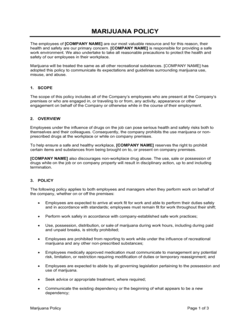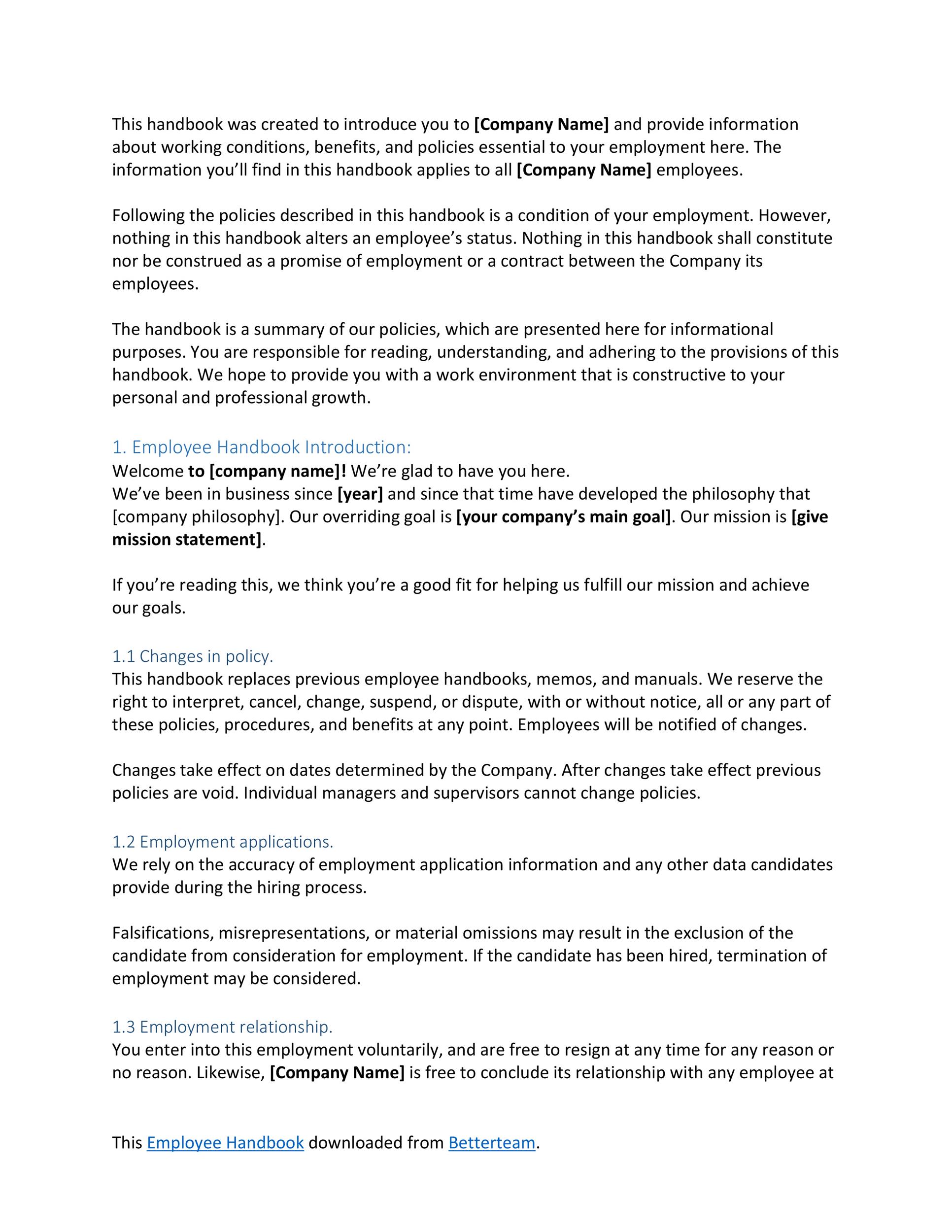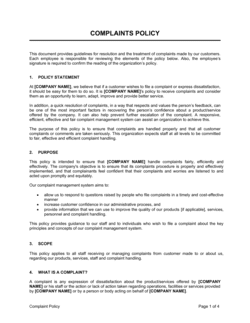Every business should follow a set of rules and procedures to keep operations running smoothly. As your small business grows, you will need a strong employee handbook to set expectations for employees. Knowing what to include in an employee handbook ...
See full list on connecteam.com. No matter how large or small your organization might be, you can derive significant benefit from having a well-crafted employee handbook that spells out your policies. The handbook should include both mandatory policies and any recommended policies applicable to your workforce.
Every business should follow a set of rules and procedures to keep operations running smoothly. As your small business grows, you will need a strong employee handbook to set expectations for employees. Knowing what to include in an employee handbook can help you better enforce your business’s rules and policies.
What should you include in an employee handbook?
Creating an employee handbook, or employee manual, allows you to reinforce workplace policies and employee guidelines. Your employee handbook should be simple and straightforward about expectations and employee rules. Outline policies and procedures that are relevant to your employees and business. Tweak your handbook to make it your own. Your employee handbook should specifically represent your business’s expectations. Consider covering the following while creating your employee handbook.
Welcome section
Your welcome section should give a brief introduction to your business and set the tone for the handbook. Your introduction may include your business’s history, core principles, and mission statement. Although this section is not required, it’s a good way to introduce your employee to your company.
Code of conduct
The code of conduct section is a guideline on how your employees should behave, dress, and represent your business. A code of conduct may include a variety of things such as a code of ethics, dress code, and workplace safety. Spell out what you expect from employees. For example, you may require professional business attire. List your dress code in your code of conduct section to inform employees on what is acceptable to wear to work.
Employment laws
Include a section on federal, state, and local laws that your business follows. You should cover your equal employment opportunity responsibilities as well as harassment, drug, and alcohol policies.
Employee classification
There are two different types of employees: exempt and nonexempt. Your employee handbook should explain the difference between an exempt vs. nonexempt employee. Consider also explaining the difference between full-time vs. part-time employees.
Pay policies
Employees will want to know how often they are paid. Clarify how frequently you pay employees (e.g., biweekly) and how many pay periods there are per year. Be sure to mention your pay grade structure and state your overtime policy as well. You may also want to include your payment methods (e.g., check vs. direct deposit) and how employees receive their pay stubs.
Attendance
Including a section about your time and attendance policy is essential. Employees must know different rules on rest breaks, holidays, and unexcused absences.
Time off policy
Your time off policy section should go hand in hand with your attendance section. Include a paid time off (PTO) or vacation time policy in your handbook. Discuss how much PTO or vacation time is earned, PTO accrual policies, and how employees can schedule time off. Your time off policy should cover paid and unpaid time off. Include rules about other types of leave like bereavement leave, sick leave, USERRA Military Leave, and FMLA rules.
Benefits policy
Providing benefits can improve engagement and employee retention. List small business employee benefits in your handbook so employees know and understand what benefits are available to them. You might include information about health care, retirement funds, workers’ compensation, disability insurance, or employee discounts.
Discipline
You should have rules in place to fairly discipline employees. Outline how you will discipline employees by listing your different tiers of discipline. For example, the first time an employee is late for work, you may give them a warning. However, if an employee is late to work three times in one week, you may give them a strike on their record. Mention what behaviors result in certain disciplinary actions. Include behaviors that lead to termination (e.g., employee theft).
New hire and separation
Cover the basic terms on employment in a new hire and separation section. This section tells employees what to expect when they are hired or if they are terminated. Include information like waiting periods for benefits, how much notice you require if an employee quits, and termination procedures.

Acknowledgment
You should require employees to sign an acknowledgment to be sure they understand everything in your handbook. After your employee reads the handbook, have them sign the acknowledgment and return it to you. Have two copies of the acknowledgment: one for the employee and one for you. The signed acknowledgment will help you if there is ever a legal dispute.
Mike Kappel is the CEO of Patriot Software. This article first appeared on the Patriot Payroll blog. https://www.patriotsoftware.com/payroll/training/blog
An employee handbook is a compilation of your company's policies and protocols, as well as employees' legal rights and obligations. Read why you need one and how to create it.' />In “Resources to Help You Create an Effective Employee Handbook,” we identified key resources to help you create an employee handbook. Now, we cover why you need one and how to create it.

Whether your small business has two employees or 20, you will have certainly created workplace policies, procedures or expectations, either formally or informally. It's essential that your employees know and understand these policies — because you'll run a more effective organization if they do and because you don't want to risk having your company break federal or state laws.
Why Do You Need an Employee Handbook?
An employee handbook is a compilation of all your company's policies and protocols, as well as employees' legal rights and obligations. Having an employee handbook makes it easy for you to communicate rules and responsibilities to employees, so there's no question about what's expected from them — or from you, as the small business owner.
Moreover, a comprehensive employee handbook helps protect your business legally if anyone ever questions whether you've clearly communicated your policies.
Example: If an employee sues you, claiming they were harassed by a coworker, you can point to the employee handbook as evidence that you have clearly spelled out anti-harassment policies in place. (Keep in mind that having worker’s comp insurance is also important to protecting your business in case an employee or customer sues.)
What Goes Into an Employee Handbook?
Like every company, every employee handbook is different. You can't simply photocopy another company's handbook and distribute it to your employees. A good employee handbook defines your unique workplace rules and practices, and should be written in a voice that reflects your vision and the culture you've built — or want to build.
That said most employee handbooks include similar topics and types of information. Below is a look at eight common sections in employee handbooks.
1. Company Values and Mission Statement
In order to be successful, your employees have to be in alignment with your company's values, missions, and goals. That's why you need to lay out those aims at the beginning of your employee handbook. All you need to do is provide a statement that encompasses what matters most to you as a company. For example, successful online shoe retailer Zappos names 10 Zappos Family Core Values that it expects employees to aspire to, including “Embrace and Drive Change' and “Be Passionate and Determined.'
2. General Employment Information
A critical component of your employee handbook is the general information about being employed with your company. This will include topics employees care about, such as:
- Hiring policies
- Payment schedule (and payment methods available)
- Full-time vs. part-time hours
- Overtime pay
- Meal and rest breaks
- Leaves of absence
- Performance review procedures
- Safety and security procedures
- Resignation and termination procedures
Keep in mind that some of this material, such as overtime pay rules and workers' compensation coverage, are at least somewhat dictated by federal and state or even local laws.
3. Anti-Discrimination and Anti-Harassment Laws
It's important to list all of the current federal, state, and local laws that are pertinent to your workforce. These can include equal employment opportunity, anti-harassment, and anti-discrimination laws.
Business In A Box Employee Handbook Pdf
4. Standards of Conduct
Beyond the requirements of law, you probably have your own expectations for how employees will conduct themselves on the job and so you'll need policies geared to specific on-the-job conduct. Such policies may include:
- Dress code
- Drug and alcohol usage policy
- Ethics policies
- Personal technology use
- Social media policy
- Data and customer privacy
- Rules around accepting gifts from clients
- Conflict resolution policy
5. Employee Benefits
As should not be a surprise to you, the employee benefits section is one of the most frequently referenced sections of your employee handbook.
Your handbook likely won't describe all the specifics of, say, your health insurance plan, as those can be quite detailed (and that information can be provided separately). But you probably want to give the basics: When is an employee eligible to enroll in the company health plan and how many options do you offer: types of plans, family coverage? When is the annual open enrollment period?
Similarly, you'll want to briefly lay out the other benefits you offer, such as:
- Vacation or paid time off (PTO)
- Any retirement plans you offer and who's eligible
- Insurance coverage you offer, including life insurance and short- and/or long-term disability
- Training benefits, including tuition reimbursement
- Any “soft' benefits you may provide, whether that's flexible scheduling, on-site yoga classes, or free lunches on Friday
Because your employees will often reference this section — who doesn't like to find out about on-the-job perks? — use it to your advantage and help them fully understand all they get as part of working for your company.
6. Confidentiality / Non-Disclosure Agreement / Conflict of Interest
Not every company includes this section, but companies that work in highly competitive industries with trade secrets and concern about employees jumping ship for a competitor may want to have employees sign a non-disclosure agreement or at least include a conflict of interest policy in the employee handbook.
7. Disciplinary Policies
It's important that your employees understand the risks of not following the policies, laws, and procedures that you lay out in the employee handbook.
Consider having a section that explains that they will be held accountable for their actions and behavior. You want employees to see that they’re receiving fair treatment and that all employees are subject to the same disciplinary process.
8. Disclaimer
It's important that your employees don't treat your employee handbook like a contractual agreement between you and them — which would mean they could sue you if the policies and procedures within the handbook aren't upheld. Thus, be sure to include a disclaimer that states the employee handbook is not a contract, to protect you against such concerns.
Pulling It Together
As you start thinking about and planning out your employee handbook, you might realize that you haven't formalized many of your policies or that you still need to consider more thoughtfully what some of your policies should be.
Don't worry — this is completely natural. Many small companies don't think concretely about their policies until they have to explain them in writing.

Here are four steps you can take to begin the process of creating your employee handbook.
1. Start With Your Culture and Values
A good place to start when thinking about your employee policies — whether specific to your attendance rules, your dress code, or your performance review process — is to think about your company's culture and values.
As the small business owner, think about your personal values and what you want to emphasize. Also consider how you can create a value system and culture that will motivate your employees to do their best and stay with your company long-term.
The culture you want to create should guide your policies and procedures — so it makes sense to at least draft a basic mission statement before designing your company's employee policies and procedures.

2. Develop Your Policies
With your values clearly identified, then think about creating policies that your employees will embrace. For example, companies looking to attract younger workers often don't want to give the impression of being too strict or overbearing — as it may turn off the millennial workers seeking workplaces that promote flexibility and openness.
That said you might — out of necessity — have to be strict about certain policies. For example, if you run a business such as retail store where showing up to work on time is of utmost importance, you'll, of course, need to specify your attendance rules and perhaps your dress code.
You then may be able to be more accommodating or generous in other parts of your workplace practices, such as by providing your employees with more vacation time.
3. Know the Applicable Laws
While the employee handbook is not a contract with your employees, it does set their expectations, so you must follow federal, state, and local laws when preparing certain parts of your employee handbook.
For example, many states have passed “leave laws' that govern how employers must handle certain types of leave, whether that's sick leave or jury duty. They may even have boilerplate language that companies can use to describe those laws to their employees. You should be able to find descriptions of your state's laws online.
You should be able to find detailed descriptions of your state's laws on your state government's website. The Employment Law Handbook by The Lunt Group also provides links to a wide variety of both federal and state legal resources, including a state-by-state breakdown of employment and labor laws.
4. Look at Other Companies' Employee Handbooks
While you shouldn't copy other companies' policies and employee handbooks word-for-word, it's well worth your time to look through some of them for inspiration or ideas.
Small Business Employee Handbook Pdf
You may already have access to other company's handbooks through friends or relatives. Take advantage of opportunities to check out at least a few other handbooks as you're planning out your policies and procedures. You can also find sample employee handbooks through a basic Google search.
